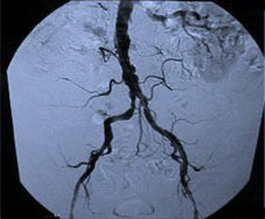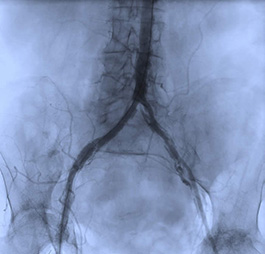Interventional Radiology
General Background

Vascular and Interventional Radiology is a method of radiology which relies upon imaging techniques, such as fluoroscopy, CT, MRI and Ultrasound to diagnose and treat a variety of conditions throughout the body, including the vascular system, the genitourinary tract, the gastrointestinal tract, the skeletal system, the chest and the abdomen. The purpose of this rotation is to familiarize the resident radiologist with the indications, contraindications, and techniques used and to enhance the clinical knowledge of radiologists in the clinical management of these patients.
Vascular procedures include diagnostic angiography, angioplasty, embolization, chemoembolizations, thrombolysis, vena caval filtration, vascular access procedures, and stent placements and TIPS. Genitourinary procedures include biopsies, nephrostomies and internal drainages, abscess drainages, Fallopian tube cannulations, tube maintenance, and retrievals. Gastrointestinal procedures include esophageal stent placements, biliary drainage, cholecystostomies, biopsies of the liver, pancreas and abdominal nodes, gastrostomies, gastrojejunostomies, abscess drainages and catheter maintenance. Chest procedures include pleural and parenchymal drainages, and biopsies. Vertebral and other bone biopsies and joint aspirations and arthrograms are also performed.
Patient Care

Procedures are performed at all affiliate facilities of the department. Routine cases are performed between 8:30 am and 6:00 pm. Emergency procedures are performed 24/7, 365 days per year.
Resident Responsibilities
The resident experience is divided into two distinct rotations: the first, completed in the second year of training introduces the resident to these procedures and gives them "hand-on" training; the second rotation increases the responsibility of the resident, allows supervised independent performance and provides opportunities to reinforce the skills learned during the first rotation, to exert increasing independent operation and to supervise and direct junior residents in the clinical management of these patients.
The senior resident radiologist is a third or fourth year radiology resident who has previously completed successfully the first rotation through the VIR service. They are credentialed to perform some procedures independently depending upon abilities and at the discretion of the Divisional Director. In general the senior resident performs procedures at the Kings County Service. He or she may do procedures at University Hospital at their discretion and depending upon the needs at Kings County Hospital.
The junior resident radiologists are in the second year of radiology training rotating through VIR for the first time. They are not credentialed for independent activities until near the end of the rotation when they undergo credentialing for vascular access and catherization.